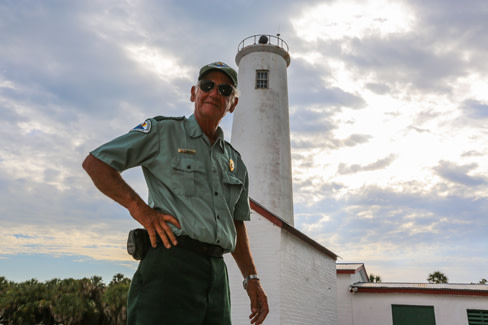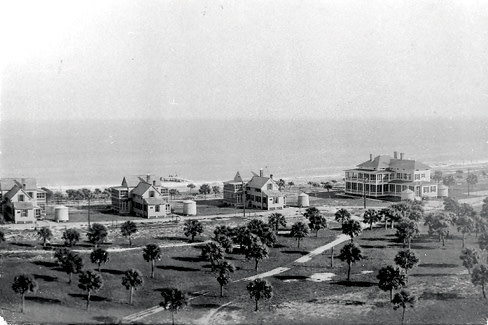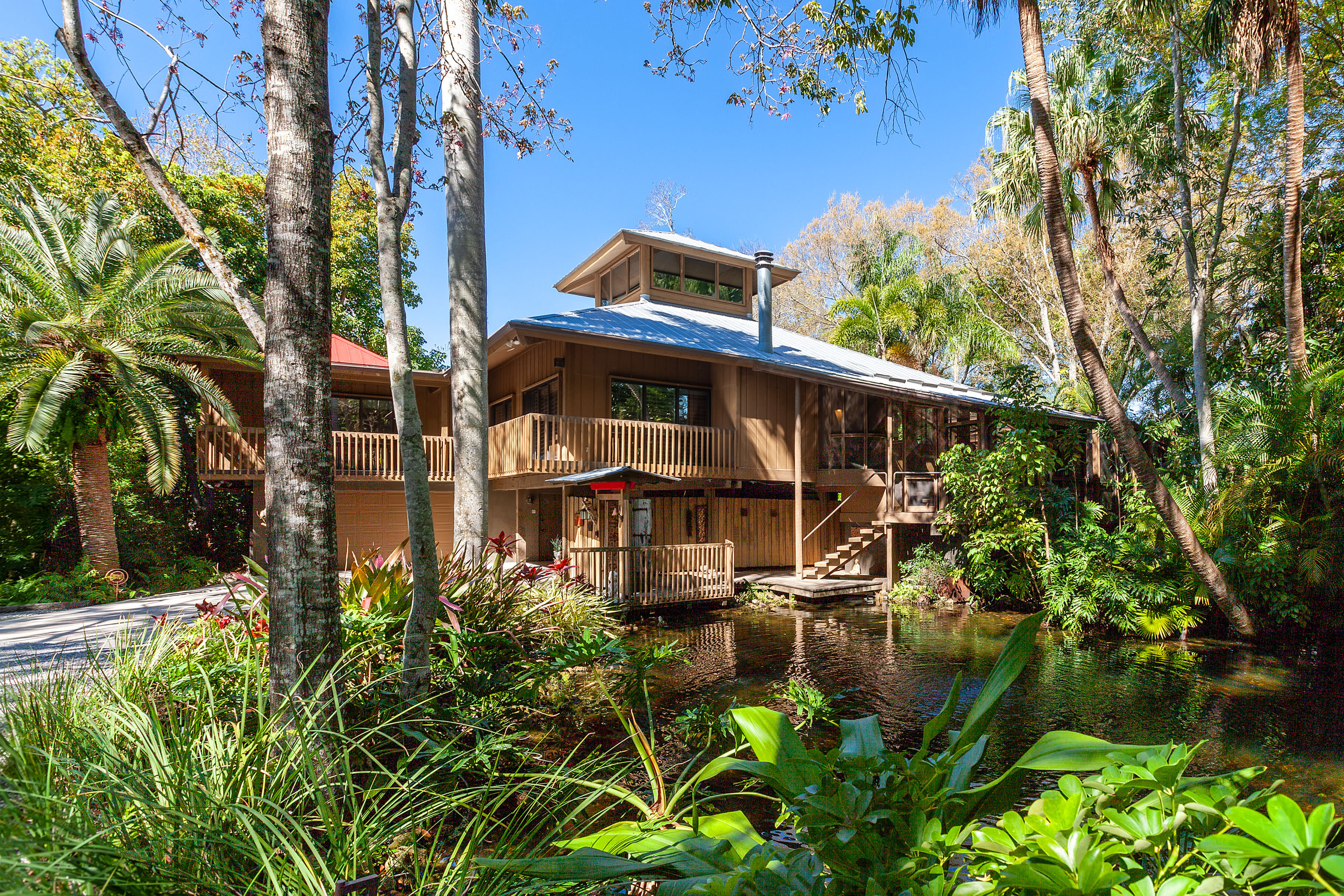The Keeper of Egmont Key
By Beau Denton | Photography by Everett Dennison

Every 15 seconds, the lighthouse on Egmont Key completes a rotation, reminding everyone in the area—commuters crossing the Sunshine Skyway Bridge, residents at home around Tampa Bay, ships out on the Gulf of Mexico—about the 250-acre island at the mouth of the bay. Egmont is as much a delta as an island, formed from centuries-old sediment deposited by the Hillsborough River, and perfectly positioned to welcome visitors to Tampa Bay—or protect the bay from not-so-welcome visitors. "I like to think that this is part of why the Tampa area grew so quickly," says Tom Watson, assistant park manager with the Florida Department of Environmental Protection. "This lighthouse told people we were here."
Watson moved to Florida from New York and started working on Egmont—first as a volunteer—about 20 years ago. For more than 15 years, he has lived on the island year-round. "I'm what they call the resident," he says—the only resident on the island, where no overnight camping is allowed and all visitors must leave every day by sunset. Watson spends his time patrolling the island in his ranger uniform, white hair peeking from the edges of his dark green cap, to collect trash, interact with visitors, organize volunteers and keep an eye on the wildlife. Egmont Key had 206,000 visitors in 2012, and Watson is there to watch them all, to make sure no one hurts himself, each other or the island. He organizes teams to collect trash, because just about everything in Tampa Bay's waters eventually washes up on Egmont's shores. Watson says volunteers put in roughly 10,000 hours keeping the island clean in 2012.
Tanned from years in the sun and lean from near constant movement, Watson wanders the roads and paths, sometimes by foot and sometimes in one of the park's golf carts, looking for something out of place or wildlife in trouble. Egmont Key is home to one of the largest populations of gopher tortoises in the country (they're the biggest animals on the island), and sometimes they need Watson's help. "The tortoises like to fight, and then one of them will get flipped over," he says. "They can't get themselves back up, so every time I turn one over I feel like I saved its life."
On weekends, when the weather is right, the water around Egmont is packed with boats. Most of the island's visitors stay near the shore, swimming and fishing in the Gulf, lounging in the sand, scouting for sea shells and snorkeling around the sunken ruins. But those who venture off the beach discover the heart of the island: not just the iconic, fully operational lighthouse, but wooded areas full of century-old ruins that tell the story of Egmont's past.
Although he's reluctant to talk much about himself, Watson will tell anyone who will listen about the island's history. Egmont's past is full of long-gone soldiers, Indians, smugglers, bootleggers, wars and storms.

In a way, it's a microcosm of the history of Florida as a whole, mapped by Spain in the 1700s and still bearing traces of English colonization (it was named for John Perceval, Second Earl of Egmont). Egmont was once a holding ground for Seminole Indians before they were sent out West, and in 1849, it was surveyed by Capt. Robert E. Lee, who praised the island's strategic position and military potential.
Egmont's first lighthouse was built in May 1848, only to be destroyed by a storm that September—the "Great Gale of 1848," still the area's most devastating storm in recorded history. Legend has it that the lighthouse keeper rode out the storm in a boat secured to a palm tree. The next day, he paddled to the mainland and resigned. In 1858, a sturdier lighthouse was built, and, though the oil-based lantern was eventually replaced by a more modern electronic fixture, that lighthouse is still standing today. Watson points out that other buildings in the area, in Ybor City, for example, are as old, but no other still serves its original purpose.
The lighthouse has become Egmont Key's icon, the focal point of its history and the first thing visitors see when approaching the island. Watson smiles as he talks about how, before Union soldiers took over the island and used it as a coastal blockade during the Civil War, retreating Confederate sympathizers removed the lens from the lighthouse and hid it somewhere in Tampa, crippling the structure for the duration of the war.
Military development on Egmont was at its peak at the end of the 1800s and the first part of the 1900s. The stone barracks and gun batteries remind of a time when military strength was determined by who controlled the waterways. On top of the batteries, visitors can still see the metal fixtures where the massive guns once stood; the two largest were called "disappearing guns," because their recoil was so powerful they would roll away from the wall and fall back into their compartments. "The biggest problem with those guns," says Watson, "was that they'd set the palm trees in front of the batteries on fire."
The island was developed as an outpost for 300 soldiers, and the number jumped to 600 during World War II, when ships entering the Port of Tampa were required to unload their arms and munitions. Watson describes this period of Egmont Key's history—from the early 1900s through World War II—with enthusiasm. It was the island's boom time.
Inland, surrounded by palms and tall grass, a network of brick roads creates a grid across the island. The roads pass the sites of old residences, guardhouses, a bakery, even a gymnasium with a bowling alley, dance floor and movie theater. There's an extensive sewer system and an old set of railroad tracks. "These guys were a whole lot smarter than we give them credit for," Watson says. "Civilian labor did all of this with mules and wheelbarrows."

But Egmont Key's boom period has come and gone. The coastal batteries and barracks are crumbling or have already been washed away, their guns long since removed. The inland town is now eerily empty. It's impressive that the brick roads are still intact, but the sites those roads pass are now little more than bare foundations.
Some of the buildings crumbled over time, and many were destroyed by fire. (Once, a whole row of empty houses was intentionally burned to root out rum runners hiding on the island.) A series of signs along the roads, with historical details and photographs from the National Archives in Washington, D.C., describes what used to stand at each spot. With more than a hint of sadness, Watson refers to those markers as "signs of what used to be."

Even with the fire and decay, Watson and his team of part-time park rangers and volunteers have made impressive progress. "We came here in 1989, and the place was such a mess," he says. "People who were here 15 or 20 years ago are amazed by what it looks like now." Watson takes pride in the improvements they have made: a simple cemetery for soldiers, Indians, lighthouse keepers and their families; a makeshift museum at the foot of the lighthouse, full of historical artifacts and an old, 1,050-pound bell; a sidewalk running along a brick road that took weeks to uncover.
Egmont Key's biggest threat, though, is not aggressive fauna or crumbling buildings. It is the constant, pounding erosion from the Gulf of Mexico and the tides sweeping in and out of Tampa Bay. Watson stands on top of a gun battery, now resting precariously close to incoming waves, and looks over the Gulf, saying there used to be two football fields' worth of land between the battery and the water. A little farther south, he points to an old, collapsed power plant. The plant was originally built as a hub at the center of the island, and now it is half-submerged on the western shore.
A survey in the 1850s estimated Egmont's land area to be more than 580 acres; today, it's dropped below 250 acres. The westernmost gun batteries, which once had 100 yards of sand separating them from the water, are now diving sites, submerged some 100 yards off Egmont's coast.
Richard Sanchez, president of the Egmont Key Alliance, says that in 2009, the Army Corps of Engineers developed a plan to install metal sheet piling below the sand, which would stem the erosion. That plan, though, will cost at least $10 million to implement. "We've brought political delegations out here to see the damage," says Sanchez, "but nobody likes the word 'earmark' anymore." In the meantime, the Army Corps has agreed that any sand it dredges up from the channel into Tampa Bay will go toward restoring Egmont; an estimated 1.3 million cubic yards will be installed in 2014.
Adding sand, though, will merely slow the erosion temporarily—which leaves Watson, Sanchez, the other rangers and their band of volunteers feeling a bit like the Dutch boy with his finger in the dike, doing their best to stem the tide.
For as long as he can, though, and as long as there is an island to protect, Watson will be there.
"Tom's a private person," says Sanchez, "but he reveals himself in different ways. He is one of the most dedicated park rangers I have ever seen, and in his stewardship of the island—the birds, the turtles and plant life—he goes far beyond the call of duty."

After nearly two decades on Egmont and familiarizing himself with every inch, it's the little things, like rescuing an overturned tortoise, that keep Watson's days interesting: hanging Christmas lights on the lighthouse to make passing ship crews smile, discovering that a simple chain can work wonders in keeping visitors out of restricted areas, finding a new artifact for the little museum, imagining out loud how difficult it would be for fully uniformed officers to trudge up and down the gun battery steps in summer. He seems to be always attuned to the history—the Seminoles forced from home, the soldiers guarding the bay, the lighthouse keepers lugging oil canisters up the tower's 85 steps—and attuned to his role as guardian of that history.
It's a balancing act. On one side are the island's past and Watson's task of preserving and restoring as much as possible. On the other side is the relentless erosion that threatens to erase Egmont—a fate Watson intends to postpone as long as he can.
Click here to see a slideshow of photos from Egmont Key's heyday in the early 1900s.




